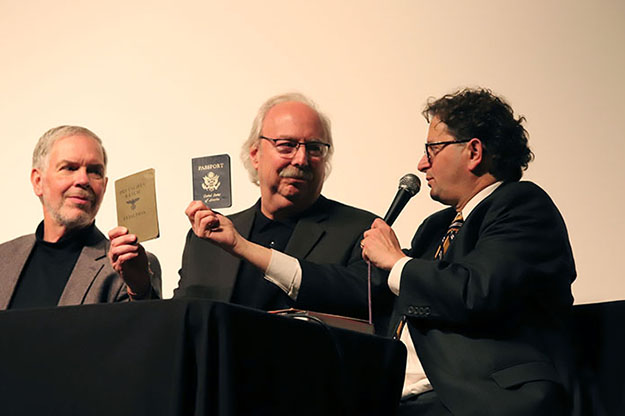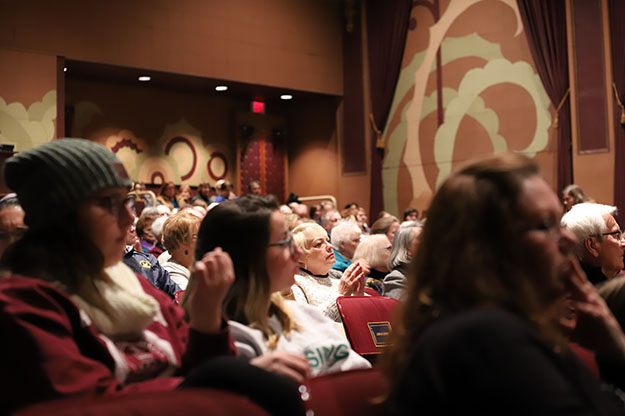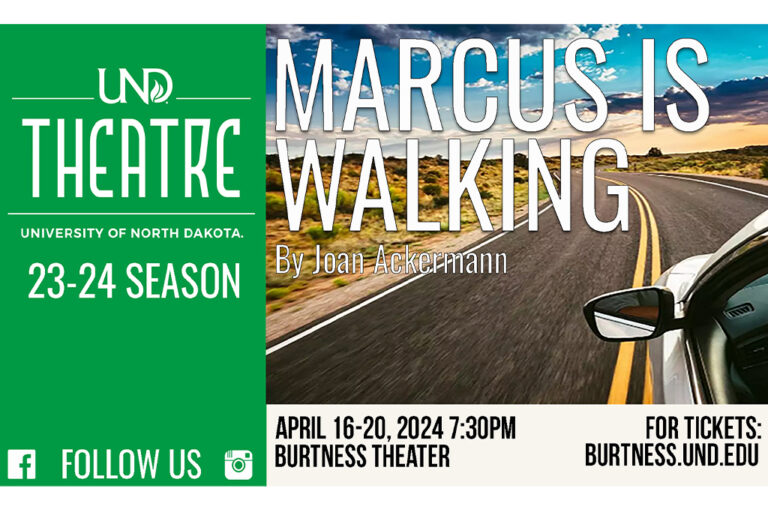A story untold too long
UND groups help bring premiere of ‘The Mission of Herman Stern’ to Grand Forks’ Empire Arts Center

The Empire Arts Center in downtown Grand Forks was at near capacity, with audience members young and old last week, for the premiere of “The Mission of Herman Stern.”
The 32-minute documentary, produced by Video Arts Studios, tells the true story of North Dakota businessman Herman Stern, who rescued 125 people from the clutches of Nazi Germany during the 1930s and 40s.
UND contributed to the creation of the project; the premiere was partially funded and organized by the College of Arts & Sciences, the Division of University & Public Affairs, and the UND-based Center for Human Rights & Genocide Studies.
UND President Mark Kennedy addressed the audience before the film, citing Stern’s accomplishments for the state and the importance of telling his story of action along with the impacts of his action. Kennedy also acknowledged Stern’s two grandchildren in attendance, as well as former U.S. Congressman Earl Pomeroy, D-N.D., who appeared in the documentary.
In our schools
In addition to producing “The Mission of Herman Stern,” Video Arts Studios also is creating lesson plans, based on the film, for North Dakota schools, libraries, museums and service organizations. The curriculum, sponsored by UND, is designed to help schools teach character, ethical behavior, determination and doing the right thing.
The filmmakers hope it can provide more of an emphasis on the history of the Holocaust and what exactly led to the mass extermination of Jewish people across Europe.

Opportunities for reflection
Following the Grand Forks premiere, a panel took the stage to answer questions and talk about the film. The panel comprised Art Philips, the film’s director and manager of Video Arts Studios; Carl Oberholtzer, co-producer and historical contributor; and Steve Hunegs, executive director of the Jewish Community Relations Council of Minnesota and the Dakotas. UND Associate Professor of History Caroline Campbell served as panel moderator.
Philips and Oberholtzer talked about their experiences making contacts and traveling around the country to hear stories about life in Nazi Germany and Stern’s impact.
Hunegs brought a pamphlet from the U.S. State Department from the time period. In reading from it, he conveyed the government’s trepidation regarding Jewish immigration. Panelists stressed that historical aspects of the documentary offer opportunities for reflection on issues faced by modern Americans when it comes to immigration and xenophobia.
Panelists also offered views on the qualities of Stern as a leader. His story is one of ethics, empathy and selflessness, they explained.

Rise of a businessman
Stern came to North Dakota from Germany when he was 16. He worked in Casselton, N.D., at the Straus Clothing store, owned by his uncle Morris G. Straus, and eventually settled in Valley City, N.D., where he managed Straus’s newest location. There he met and married his wife, Adeline. As family members left the area, Stern eventually became owner and manager of Straus Clothing.
The documentary follows the history of Nazism’s rise to power in German society, emphasizing the bigoted and exclusionary practices following its wake. Survivors of the time period, featured in the documentary, recall their experiences of persecution. Soon after Adolph Hitler’s ascent to power, it wasn’t safe for Jewish people of Germany to remain.
“The Mission of Herman Stern” also brings to light the antisemitism and isolationist attitudes of post-World War I United States and much of the Western World. The U.S. State Department’s efforts to curb immigration made taking on Jewish refugees an incredibly difficult task. As Stern and his wife received correspondence from relatives in Germany, they knew something had to be done to get them out of danger.
Ally in Congress
Stern researched immigration regulations extensively, searching for ways to get his family to the United States. He found his first spot of success in an educational clause that allowed school-aged relatives entry.
Soon Stern began corresponding with U.S. Sen. Gerald Nye, R-N.D., an isolationist firebrand and noted anti-Semite. Nye was familiar with Stern because of his success with Straus Clothing and as a business leader across North Dakota. Interestingly, Nye eventually became an important ally in Stern’s ability to sponsor visas and arrange for refugees’ passage to the country.
Indefatigable writing and research by Stern and his wife saved 125 people from certain incarceration and death in the Holocaust. The descendants of those saved offered their stories and voiced gratitude to Stern in the documentary, many attributing their very existence to Stern.
Before the documentary, Stern’s business contributions to North Dakota had been the more public aspects of his legacy, as he never spoke much about his rescue efforts. He is known for founding the Greater North Dakota Association and served as its first president. He also started the North Dakota Winter Show in Valley City, and launched Boy Scout Councils in multiple North Dakota cities.
He posthumously received the North Dakota Theodore Roosevelt Roughrider Award in 2014, the highest award given to North Dakota citizens.



